In Silicon Prairie, Kenzie Academy’s Apprenticeship Program Trains Students for High-Paid Tech Jobs of Tomorrow — Without College or Debt
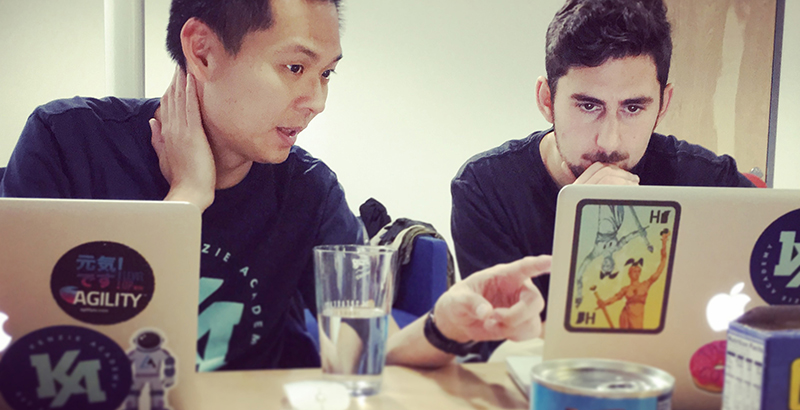
Indianapolis
Unlike many of his peers, Dylan Fields, a high school senior in a small town just north of here, has long known what he wants to do for a career. But like many others, Fields had no idea how to get from where he was to where he dreamed of being.
”I’ve watched more YouTube videos about software engineering than 99 percent of people,” he said. “It’s insane.”
Problem was, Fields, 17, didn’t how to get from Zionsville — a suburb of 26,000 — to a high-paying job as a software engineer. He visited colleges like Purdue and Vanderbilt universities and the University of Chicago, but the visits left him hesitant about whether formal postsecondary education was right for him.
“There was always a part of me that was unsure,” he said. He often wondered, “Is this the place for me?”

Then, in January, Fields shadowed his older cousin at Kenzie Academy, a tech-focused apprenticeship school that had just opened in downtown Indianapolis. He was struck by the hands-on nature of the program. With its flipped classroom model, much of Kenzie’s formal content learning takes place after hours or in the first part of the morning, and students spend the rest of the day working with their coach, instructor, and classmates to try out new skills.
“It was a completely different feeling,” Fields said, recalling himself thinking, “Oh yeah, I’m going to come here.”
Fields applied and was accepted. After he graduates from high school this spring, he will forgo college and instead enroll in a two-year program at Kenzie, hoping the program’s unique funding model will permit him to start the program without taking out a loan and that its apprenticeship model will provide him with real-world experience before graduating.
With millions more jobs requiring at least some postsecondary education but student loan debt totaling more than $1.5 trillion, students, parents, and employers are all eager for alternatives to college. Kenzie co-founder Chok Ooi, who tinkered with computers as a teenager in his native Malaysia, is betting he can help fill the gap. And with experience on Wall Street and a successful Silicon Valley startup, Ooi, 38, believes that apprenticeships will help him turn an expensive, four-year, tech-focused degree into an affordable vocational program — and produce workers for Indianapolis’s burgeoning tech scene.
“We want to make apprenticeship sexy again,” Ooi said with a laugh.
Students will begin their apprenticeship once they reach their second year. The school, Kenzie Academy, is developing a consultancy arm, Kenzie Studios, where apprentices will work with experienced technologists and attempt to apply what they’ve learned for paying customers. (Kenzie will also run a corporate retraining program for midcareer employees at other organizations.) The hope, Ooi said, is that the apprentices will collect a yet-to-be-determined apprentice wage while building relationships that could lead to postgraduation employment.
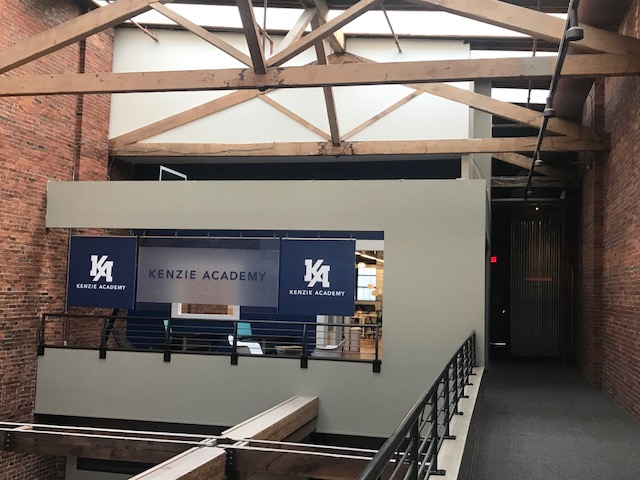
Employment is key, as Kenzie’s financial model is largely premised on its students finding well-paying jobs after graduation. Like Purdue, Kenzie is experimenting with income share agreements, which means students don’t pay any of the $24,000 tuition up front. Instead, they agree to pay back 17.5 percent of their postgraduation salary to Kenzie for 48 months. Students who get low-paying jobs could end up paying less than $24,000, and students with high-paying jobs could pay more. Students who do not find work, even with Kenzie’s support, will not pay the tuition.
“That’s why when our students are struggling, we pay special attention to them,” Ooi said, “because our future income depends on them.”
Silicon Prairie
Ooi’s path to developing an alternative to college in Indianapolis started when he attended college in — Indianapolis. Born in Malaysia, where he built his own computer and launched a website for his high school at age 16, Ooi met a recruiter visiting from Indiana University–Purdue University Indianapolis. He faxed her a newspaper article about launching the school website. This encounter won him a scholarship to IUPUI, where he soon enrolled. The “Crossroads of America” became the first place in which he set foot in the United States.
Ooi eventually transferred to the University of Texas at Austin, and he landed on Wall Street after graduation. He was working at Goldman Sachs when the financial crisis struck in 2008 and headed off to Silicon Valley soon after. In 2011, Ooi and a business partner launched Agility.io, a company employing 250 software engineers in Vietnam to do outsourced work from tech firms like Samsung, Viacom, and Bose. Agility.io taught every single one of its employees to code from scratch.
Now, with Kenzie, Ooi says, “We’re trying to take what works for Agility and adapt it to middle America.”
Ooi says Indiana’s biggest selling point is its state government “being very pro-business.” Among other policies, the state has a business-friendly tax environment and invests in workforce development programs like Kenzie.
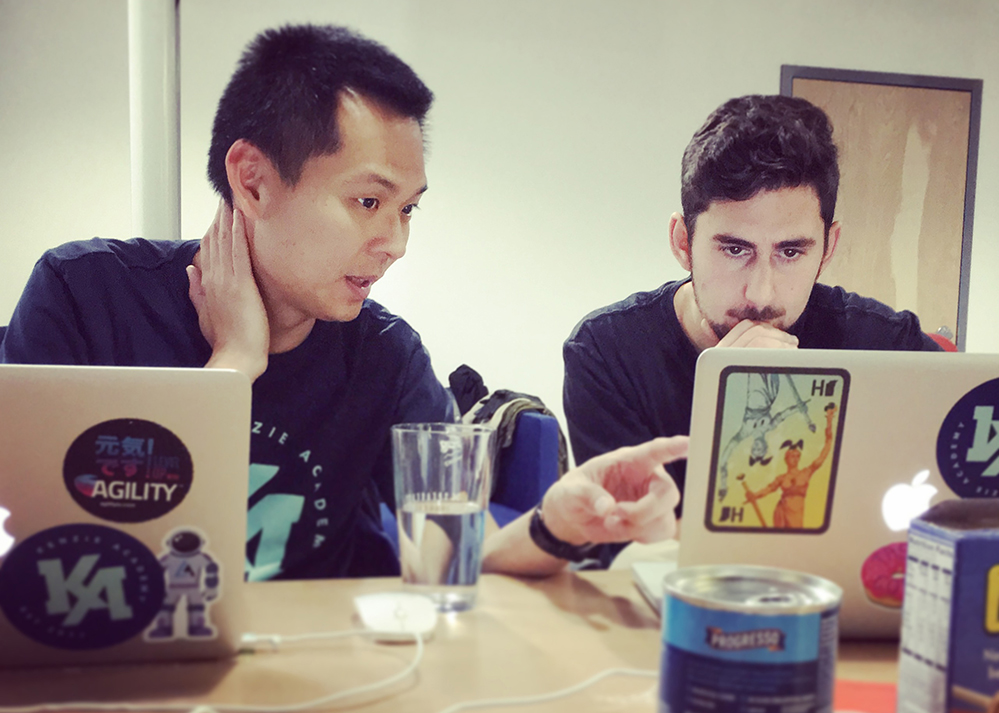
In 2016, Vice President Mike Pence — then the governor of Indiana — called the state “Silicon Prairie,” a moniker that other Midwestern cities and states have applied to themselves. But Indiana has an increasingly strong claim to the title.
In 2015 and 2016, tech jobs expanded in the Indianapolis area at the fourth-fastest rate in the country and the highest in the Midwest, according to a report last year by real estate firm CBRE. In January, Amazon announced that Indianapolis was among 20 finalists from more than 230 cities and regions that are seeking to host the tech giant’s second headquarters. SalesForce has its name on the tallest tower in town, and Infosys, the global technology company, is in the midst of building its American training facility in Indianapolis — with plans to fill 3,000 new jobs there over the next five years.
Mike Langellier, president and CEO of TechPoint, an Indianapolis-based tech advocacy organization, says the city’s emergence as a tech center is the result of several macro trends.
First, he points to the costs and congestion in traditional tech hubs like the Bay Area, Seattle, and New York City, which are “hitting the point where they’re becoming unsustainable to scale companies there on a reasonable cost basis,” Langellier said.
Mike Cammarano, who lives in Silicon Valley and works remotely as Kenzie’s head of curriculum, is experiencing the challenges firsthand.
“Everything here is really dysfunctional,” he said. “All of the housing prices are extremely high, the highways and railways are maximally congested. There’s this obvious opportunity to develop other tech hubs in other parts of the country that aren’t facing these same types of constraints. Most people around here appreciate the fact that this makes sense.”
Second, Langellier notes that technology and the internet are now embedded into everything from the watches we wear to the tractors we drive (or, with GPS, the tractors that can drive themselves).
“Until now, we’ve primarily engaged with the internet, and now the internet is engaging with physical objects around us,” Langellier said. “That’s causing technology to inject its way like never before into areas like sciences and health care and agriculture and logistics, and it just so happens that the cores of many of those industries are in other parts of the country, like Indianapolis.”
Indianapolis is now a city where IndyPy, a Meetup group for the Python programming language, has more than 1,400 members. It’s where the tech community pushed back when the state legislature passed what it views as overly conservative legislation. It’s also where the governor of the state came to Kenzie’s kickoff event when the school had only 18 students.
The tech companies moving to Indianapolis are looking to capitalize on a strong educational and philanthropic landscape. Indiana University’s main campus and Purdue University are both located just over an hour away, as is Rose-Hulman Institute of Technology, which U.S. News and World Report has ranked as the best engineering school in the country for 20 straight years. There’s also Ivy Tech Community College, which serves nearly 200,000 students annually.
Educational nonprofits like The Mind Trust, the Strada Education Network, and the Lumina Foundation are all based in Indianapolis. Global pharmaceutical company Eli Lilly is headquartered there, too, and its endowment is “one of the largest grant-making foundations in the United States.” Indianapolis is also home to SalesForce’s biggest hub outside of San Francisco; in May, the company donated $500,000 to Indianapolis Public Schools.
In tech parlance, Indianapolis — with its talent pipeline, supportive network, and business-friendly government, not to mention its affordable cost of living — has all the makings of a strong ecosystem.
“Not a lot of drama around here,” said Maureen Donohue Krauss, who oversees economic development at the Indianapolis Chamber of Commerce. “Some people consider that dull. I just consider it easy to succeed.”
‘Our future is tied to our students’ futures’
How easy to succeed?
Ooi got the idea for Kenzie in the spring of 2017 while on a trip to Africa organized by Geeks on a Plane, which coordinates overseas trips for entrepreneurs. In Nigeria, he learned that Andela, which helps train software engineers, was receiving business from American companies, and he realized he could start a similar organization to do that work in the heartland.
“A bunch of my friends said, ‘If you do it, we will write you a check,’” Ooi said. “So I raised $1.1 million in three weeks after the trip.”
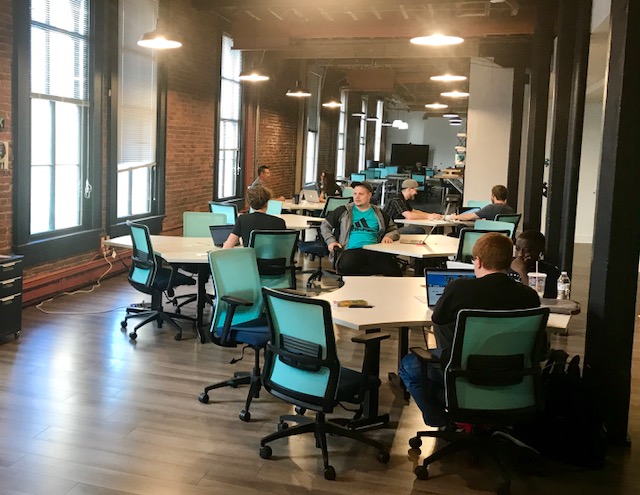
With that money in hand, and entrepreneur friends Rehan Hasan and Courtney Spence as his co-founders, Ooi launched Kenzie. They eventually raised $5.8 million over two rounds of funding, with hopes of serving 1,000 students over the next five years.
Kenzie started offering classes in January this year, and as of September they had about 50 students spread across four cohorts. The students range from 19 to 52 years old, and many students already have an associate’s or bachelor’s degree (including Dylan Fields’s cousin, who graduated from Indiana University).
To gain admittance, students start by filling out an online application for one of three programs: software engineering, user experience (UX) engineering, and digital marketing. The application includes questions like, “At 1:14 p.m. in Indianapolis, Indiana, what time is it in San Francisco, California?” and, “If your friend walks a mile in 15 minutes, what is her speed in miles per hour?”
“It’s a relatively low bar,” said Cammarano, the head of curriculum. “It’s essentially a screener that people have a basic level of English language literacy and computer literacy.”
A subsequent stage of the process includes a technical interview with an instructor, though Kenzie staff say they are looking to see how applicants think and how they respond to setbacks more than they are looking for previous coding experience.
“The core of it is metacognition — thinking about how you’re thinking,” said David Gregg, an associate instructor in the software engineering program.
Once admitted, students begin a full-time program. In the first year, direct instruction is limited, partly because Ooi believes in a more hands-on approach. Lecturing, he said, “kills the creative daylight out of you.”
Students attend class across two floors of loft space above the Hard Rock Cafe. There’s an emphasis on collaboration, so walls are kept to a minimum. Meeting rooms that do exist are named after employees’ children or pets. Students work on laptops at long tables and roll their desk chairs into a semicircle when an instructor delivers a mini-lesson. There’s one basketball hoop and many bikes.
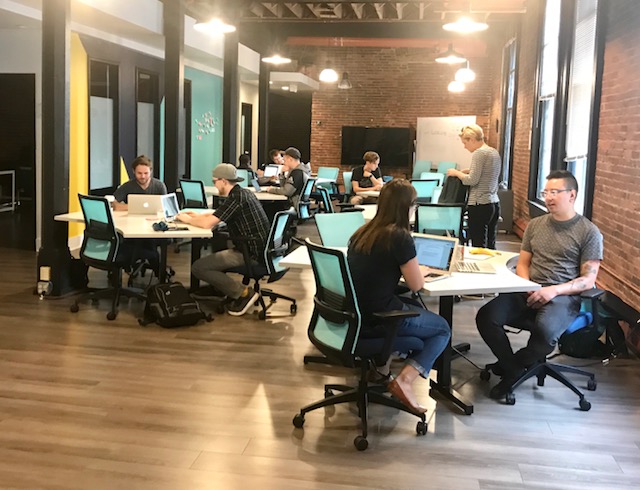
Students are introduced to new skills and content through brief demonstrations and online videos. They then practice applying the content through a variety of exercises on Kenzie’s online learning platform. Students can help one another, and there are also coaches (students from earlier cohorts who have already gone through the curriculum) and instructors available for support.
Not all instruction happens in person. Because Ooi says he prioritizes “the best talent,” some instructors teach remotely via video and primarily engage with students through Slack, a messaging app. The UX engineering program, for instance, is taught by a former LinkedIn UX designer who lives in New Orleans and a former Google UX designer who lives in New York. They visit Indianapolis periodically. (This is not unusual — Ooi’s family lives in New Jersey, where he visits on weekends, and his co-founders live in Colorado, as do other members of his team.)
Ooi hired an alumnus of Teach For America to coach his instructors, recognizing that industry experience doesn’t necessarily translate to strong teaching. Kenzie is also spending more in advertising to attract more women and more minorities because “long-term, it pays off,” Ooi said.
Kenzie staff tend to describe the company by emphasizing what it isn’t — a coding boot camp. They note that Kenzie’s program is much longer and includes a year of apprenticeship, compared to the intensive courses that tend to last around 15 weeks and have proliferated in recent years. Since its launch seven years ago, General Assembly, for example, has reached more than 40,000 students and now counts 25 locations in the United States and six overseas. The Flatiron School, another coding boot camp, has expanded to six locations since WeWork acquired the school in October 2017.
Kenzie is also not a registered apprenticeship program, which is a classification given to programs that meet certain criteria and apply to the U.S. Department of Labor. In turn, these programs are eligible for federal funding — an initiative that started under former president Barack Obama with $175 million in 2015 and continued under President Donald Trump, who committed $200 million last year.
That lack of official status gives pause to Angela Hanks, who directs the Center for Postsecondary and Economic Success at CLASP, a think tank focused on low-income Americans.
“It doesn’t necessarily mean that it’s not a quality program, but it means you can’t compare it to a program where there’s a requirement around the wage progression and multiple requirements around labor standards and mentorship,” she said. “In some ways this is an experiment where they’re trying several things at once.”
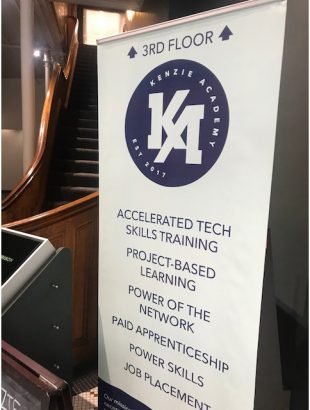
Mary Alice McCarthy, who worked on apprenticeships as an official at the Departments of Education and Labor during the Obama administration, is excited to see the model extending beyond traditional trades like plumbing and carpentry, and she thinks apprenticeships are more effective than the boot camp model. McCarthy notes, however, that apprenticeships are normally free or available to employees at a minimal cost, a far cry from Kenzie’s $24,000 price tag, which includes the year in Kenzie Studios.
“It’s a little concerning when a company is training up its own consultants but charging people to be their own consultants,” she said.
For Kenzie student Jennifer Browning, 42, all concerns are relative. In early July, she was incarcerated at the Indiana Women’s Prison, finishing a 15-month sentence for repeated arrests for driving under the influence and possession of opioids without a prescription.
By late July, after a meeting with Ooi, she was a student in the newest software engineering cohort at Kenzie. Ooi said there are a handful of students who were formerly incarcerated.
“We believe in giving people a second chance, and what better way — they can do work under our apprenticeship, where people don’t question your past, they just care about the delivery of the work,” Ooi said. “After they deliver good work, nobody will typically care anymore. They’re like, ‘What can you do?’ versus ‘Tell me about your past.’”
Browning, a mother of four with a bachelor’s degree who worked as a stockbroker for Charles Schwab earlier in her career, overflows with gratitude at the second chance.
“My family is super excited because I think they were worried about what am I going to do when I get out, are the opportunities going to be limited?” Browning said. “I think it’s God’s will.”
The future of higher ed
John McDonald, the CEO of ClearObject, a 40-person IT company based just outside of Indianapolis, is not a fan of traditional higher education. He notes that roughly 70,000 of the state’s high school seniors graduate each year, and about half of them go to one of Indiana’s public colleges or universities. In two years, 8 percent of those students graduate with an associate’s degree; in four years, 42 percent graduate with a bachelor’s degree. Of those graduates, two-thirds have debt. In other words, of those 70,000 high school graduates, just 5 percent — 3,634 of them — graduate on time and without debt.
“To call that system broken is a disservice to the word ‘broken,’” McDonald said.
At work, McDonald’s company posts job descriptions that ask for a “BA/BS degree in Computer Science or related technical field or equivalent practical experience.”
“We want a [bachelor’s degree], but if you can prove you have relevant experience, we don’t care,” he said.
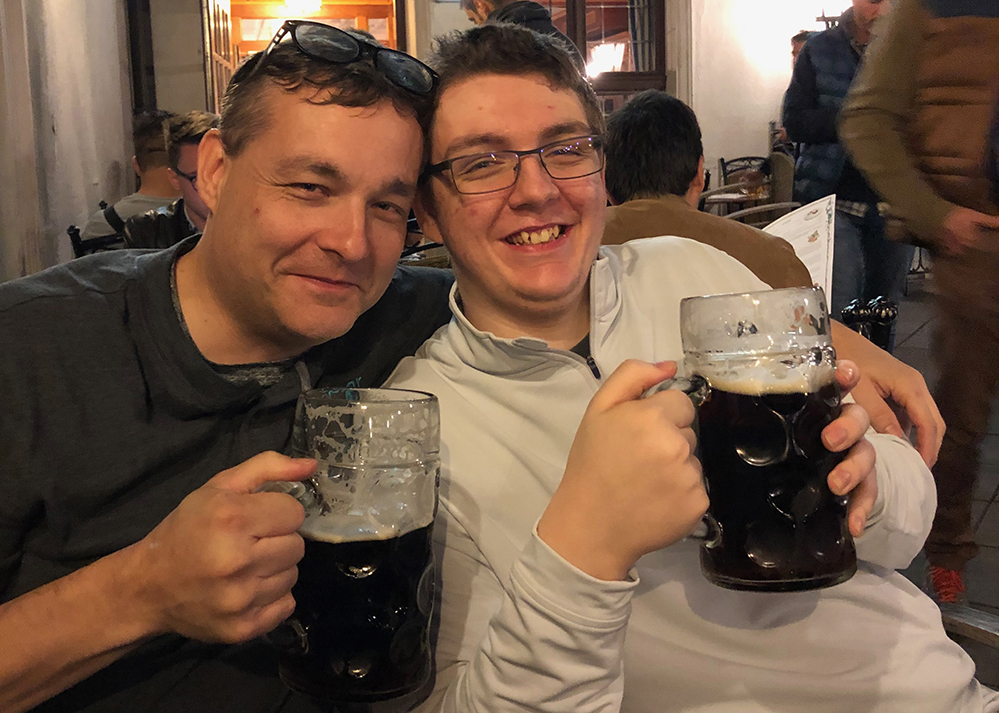
At home, two of McDonald’s three sons have already graduated from high school; one is taking community college classes, and the other attends a coding academy.
“The only place where I might have influenced the outcome is by not influencing the outcome,” he said. “I didn’t push them to a traditional college because that system doesn’t work for them.”
As further evidence, McDonald references a 2016 Kauffman Foundation report that shows that although college graduates used to be twice as likely as high school dropouts to own a business, today they own businesses at nearly the same rate.
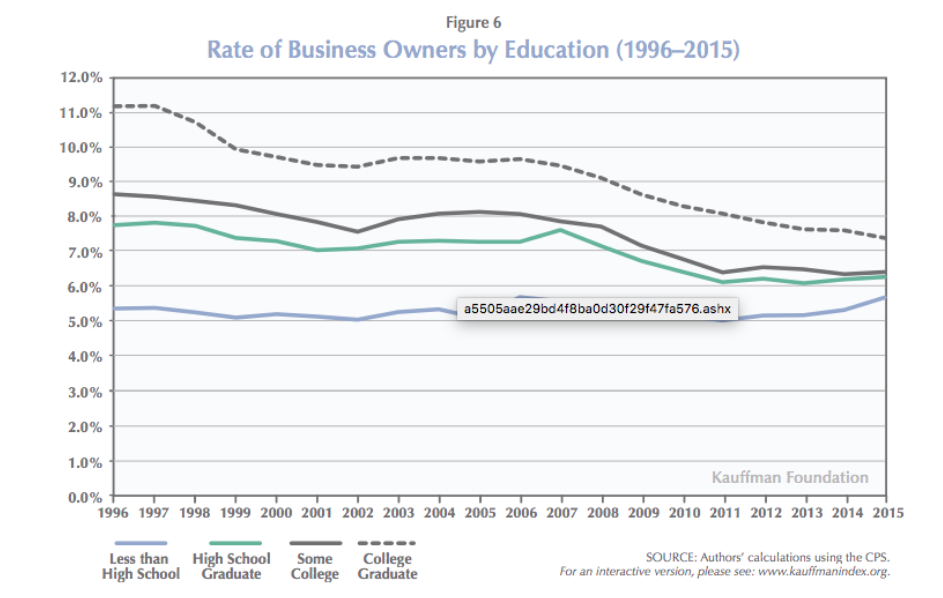
“[Young people today] can build a website, they can code an app, so they’re going into business for themselves … and offering skills they’ve learned largely on demand to other people, largely on demand,” McDonald said. The current higher education system is “absolutely, completely busted. It’s bankrupt. And our kids know it.”
Not everyone in Indianapolis is so quick to scrap the system.
Scott Bess is the head of school at Purdue Polytechnic High School, a district-charter hybrid that opened downtown two years ago. Bess is quick to jettison some parts of traditional education — Purdue Polytechnic uses a project-based model instead of conventional subject-based classes — and he is a fan of Kenzie; about 20 students and one teacher took coding classes there over the summer. But he’s not ready to take college off the table for his students, partly because his school partners with Purdue University, and partly because statistics still show that the more education you have, the more money you make and and the less likely you are to be unemployed.
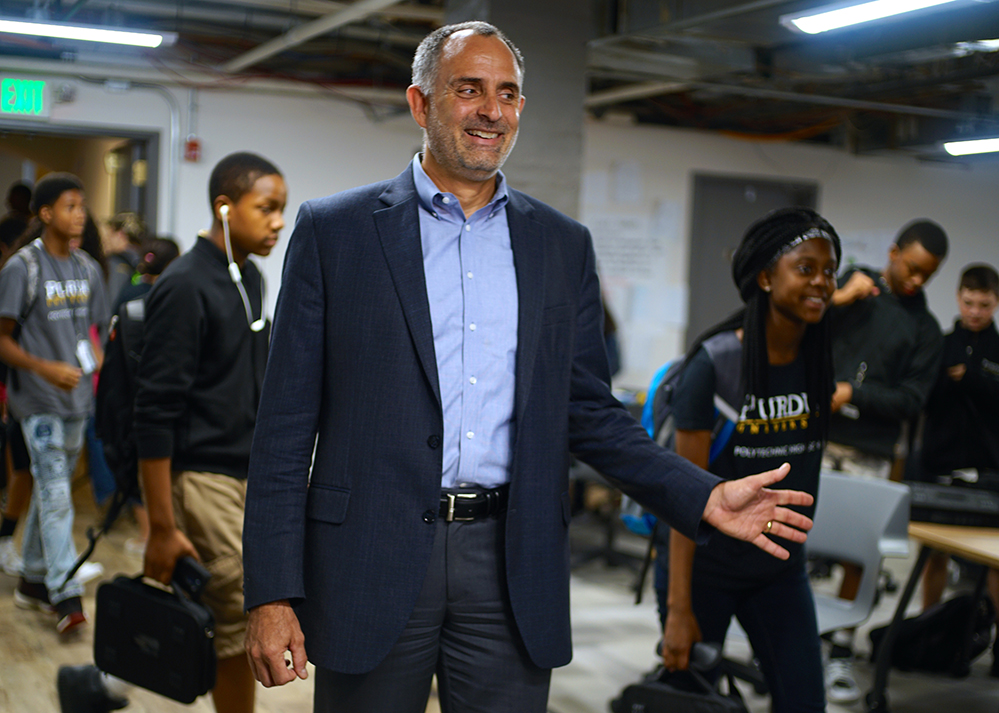
“I don’t want to take that option away from people because we don’t know if 10 or 15 years from now if that differential goes away through people like Kenzie,” Bess said. “Maybe it does, but if it doesn’t, I don’t want our students to be locked in, like, ‘Shoot, I made the wrong choice when I was 18 years old.’”
Bess thinks it might be possible to integrate elements of traditional and nontraditional postsecondary education, combining the institutional resources and supports of a college or university with the industry responsiveness of Kenzie. An example of this, Bess said, would be a university outsourcing its software engineering curriculum to Kenzie.
McCarthy, the former official in the Departments of Education and Labor, agrees on the possibilities for collaboration. She thinks colleges should start partnering with apprenticeship programs, given how apprenticeships “smooth the transition from school into work and keep the education system well connected to the labor market and what firms and companies need.”
McCarthy thinks there’s a model where on-the-job learning related to classroom instruction could earn students credits, similar to the system in the United Kingdom, where colleges are trying out degree apprenticeships.
“They take the best of both worlds,” she said. “Folks are working while they’re studying, and it’s much more experiential and hands-on. Their education has a longer shelf life and will be more important to them later in life.”
Ooi said Kenzie already has a partnership with Indianapolis-based Butler University and is exploring further coordination with institutes of higher education.
Far more jobs today require postsecondary education (65 percent) than 40 years ago (28 percent), and more models are being developed to fill that need.
“Things like Kenzie fill the hole for the people that need another way,” ClearObject CEO McDonald said. “And, in reality, we all need another way,”
Disclosure: This is the first in a series of Future of Work cover stories sponsored by Pearson exploring how automation and evolving economic forces are impacting education from kindergarten through college.
Get stories like these delivered straight to your inbox. Sign up for The 74 Newsletter

;)